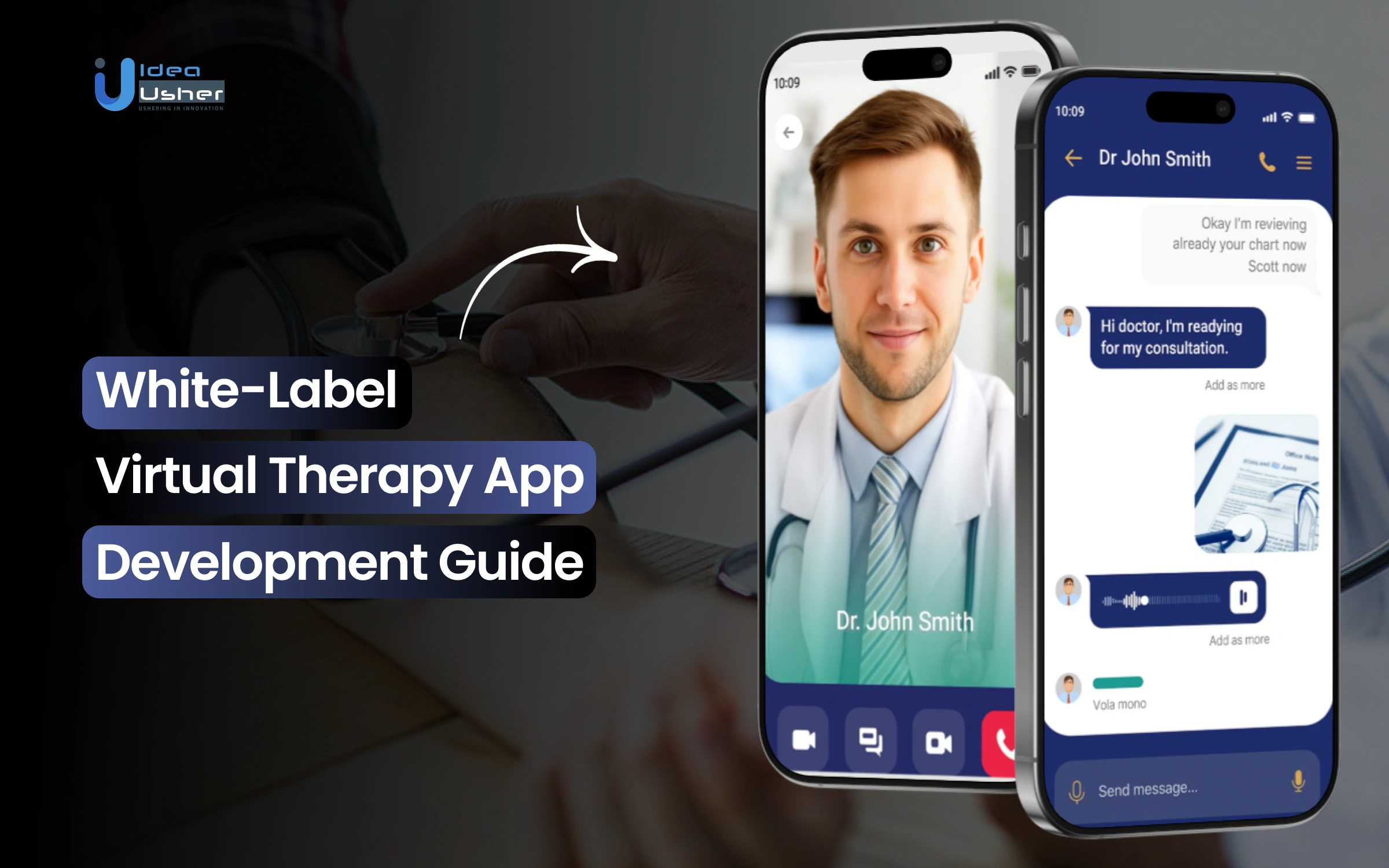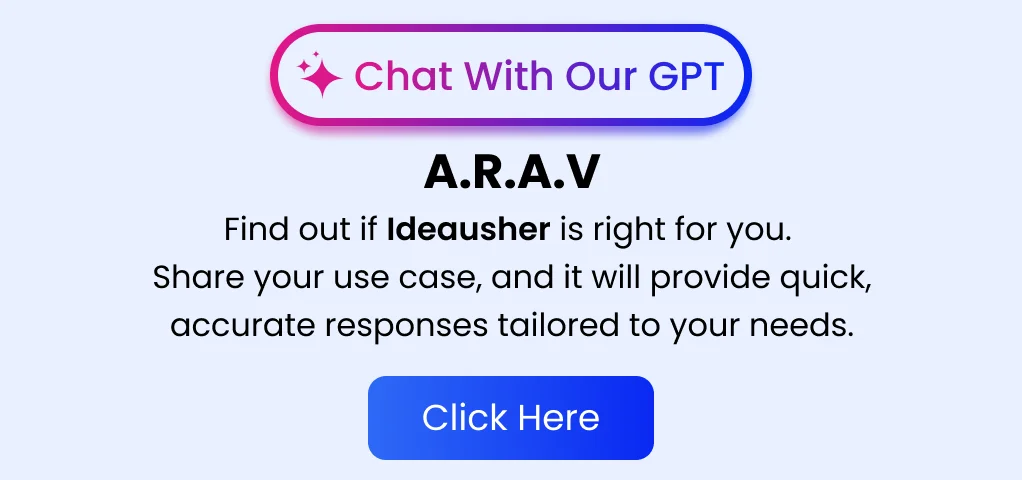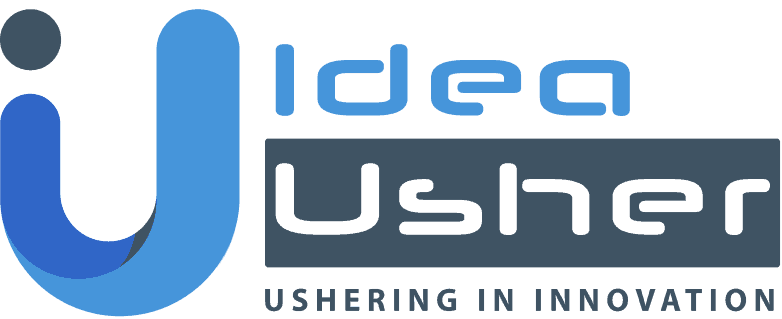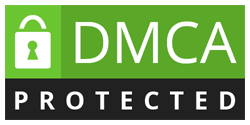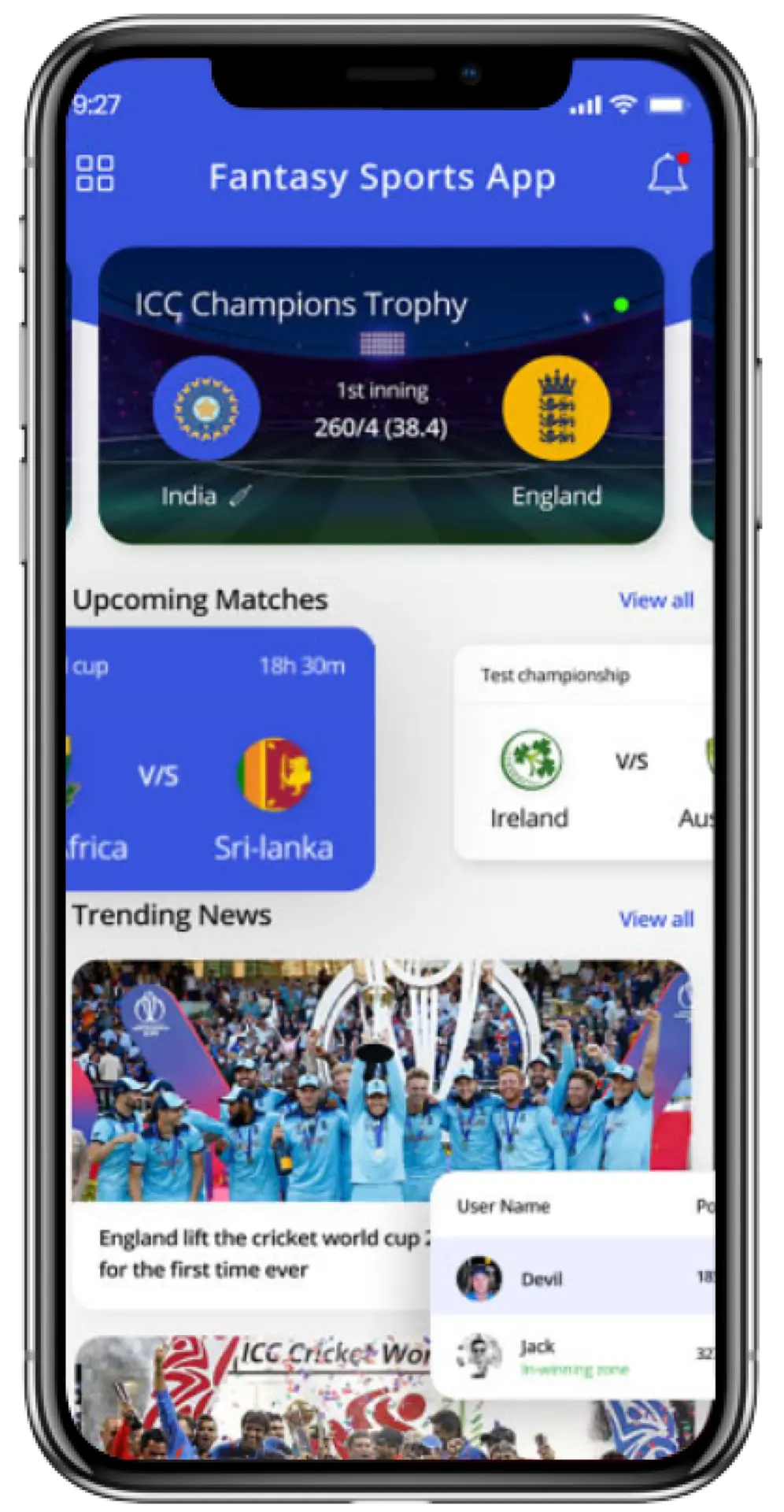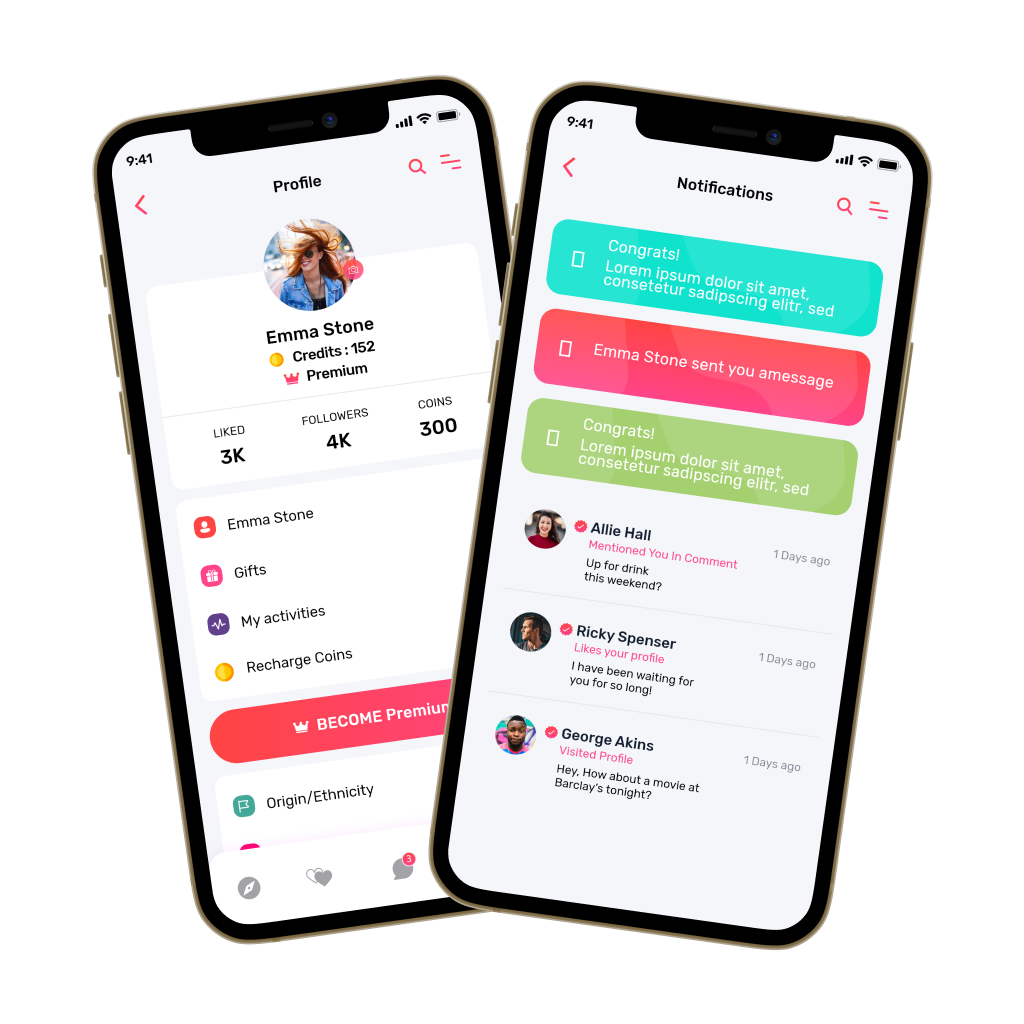Digital therapy is now the first choice for many people looking for support. However, building a therapy platform from scratch is usually not practical. High development costs, strict compliance requirements, and the need to launch quickly lead many organizations to look for better options. A white label therapy app offers a ready-made option that you can customize to fit your brand, goals, and audience.
These solutions help clinics, startups, and wellness brands launch scalable virtual therapy platforms quickly and easily. With features like video calls, scheduling, secure chat, and AI-driven personalization, white-label apps offer the same benefits as custom-built products, but they are faster to set up, simpler to use, and much more affordable.
In this guide, we’ll cover everything you need to know about white-label virtual therapy app development, including how it works, which features are most important, the technology involved, and what it might cost. If you want to launch your virtual therapy app, this blog will help you turn your idea into a fully branded digital therapy solution. With experience in healthcare solutions, IdeaUsher supports businesses in creating efficient, compliant, and market-ready virtual therapy platforms.
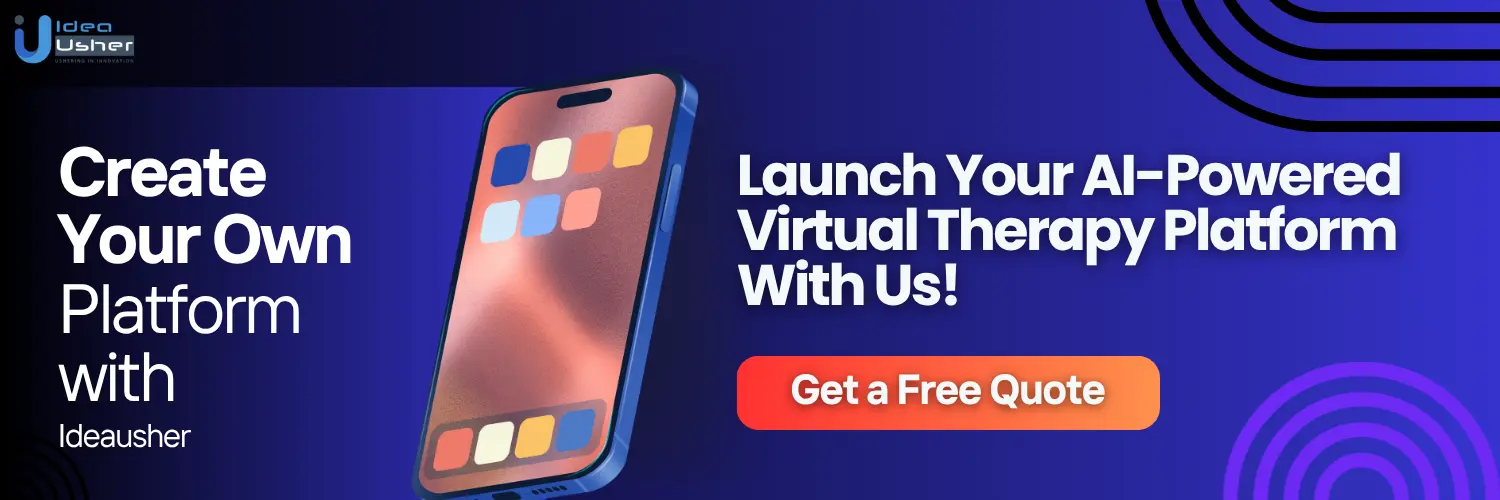
What is a White-Label Therapy App?
A white-label therapy app is a ready-made digital platform for mental health services that businesses can customize and launch with their own branding. The main features, such as chat, video sessions, AI assistants, and progress tracking, are already included. Companies can adjust the design, logo, colors, and integrations to fit their brand.
As digital mental health solutions continue to evolve, more startups, clinics, and healthcare providers are turning to white-label platforms to accelerate innovation, reduce costs, and enter the market faster.
- Faster Go-to-Market: Pre-built frameworks let startups and clinics launch therapy platforms in weeks instead of months, reducing time-to-market drastically.
- Lower Development Costs: Eliminates the need for full-scale app development; organizations only invest in customization, branding, and integrations.
- Regulatory Compliance Built-In: Most white-label solutions already meet HIPAA, GDPR, and healthcare data security standards, saving time and legal overhead.
- Seamless Branding Flexibility: Clinics and digital health startups can personalize UI, color themes, and content flow to reflect their brand identity and trust factor.
- Scalability & Feature Expansion: The modular structure allows easy integration of AI-driven features, analytics, and new therapy modules as the business grows.
- Focus on Care Delivery, Not Coding: Teams can spend more time improving therapy outcomes, client experience, and engagement, while the technology remains stable and well maintained.
White-Label vs. Custom Therapy Apps
When developing a digital mental health platform, one key decision is whether to choose a white-label solution or build a custom app from scratch. Each approach offers unique advantages depending on your goals, timeline, and budget.
| Aspect | White-Label Therapy App | Custom-Built Therapy App |
| Development Time | Launch-ready within weeks since core modules are pre-built. | Takes several months to design, develop, and test from scratch. |
| Cost Efficiency | Lower initial investment due to pre-developed infrastructure. | Higher development cost as everything is built uniquely. |
| Customization Level | Moderate customization – branding, UI elements, and feature tweaks. | Fully customizable – tailored workflows, UI/UX, and integrations. |
| Maintenance & Support | Handled by the white-label provider, minimizing in-house tech effort. | Requires a dedicated in-house or outsourced development team for updates and fixes. |
| Scalability | Scalable to an extent but limited by the provider’s infrastructure. | Fully scalable based on specific business needs and tech stack. |
| Compliance & Security | Comes with pre-built HIPAA/GDPR compliance frameworks. | Compliance must be implemented manually, offering more control but requiring expertise. |
| Integration Options | Limited to supported APIs and partner tools. | Can integrate any preferred third-party systems, EHRs, or analytics tools. |
| Time-to-Market | Ideal for fast market entry or MVP testing. | Suitable for long-term, large-scale product roadmaps. |
| Ownership | App ownership remains with the white-label provider; client licenses it. | Full ownership of source code, data, and intellectual property. |
Workflow of a White-Label Virtual Therapy App
A white-label virtual therapy app lets businesses offer personalized mental health services under their brand, streamlining access to support with a smooth workflow from onboarding to sessions and tracking.

1. User Registration & Profile Setup
Users register via the app and create personalized profiles, adding relevant details such as therapy preferences, goals, availability, and, in the case of therapists, credentials and specializations. This onboarding process helps the platform tailor experiences from the start.
2. Service Discovery & AI-Assisted Matching
Patients explore available therapy services and browse therapist profiles. AI algorithms analyze patient preferences, session history, and emotional cues to recommend the most suitable therapist or therapy program, ensuring a personalized match.
3. Scheduling & Appointment Management
Users book therapy sessions through an integrated calendar system. Automated confirmations, reminders, and rescheduling options streamline session management for both patients and therapists.
4. Secure Session Access
Therapy sessions are conducted within the app via encrypted video calls or chat, ensuring confidentiality and compliance with healthcare standards. AI tools may offer real-time transcription to enhance accuracy.
5. AI-Assisted Documentation & Emotional Analysis
During sessions, AI-powered transcription captures dialogue and automatically generates structured clinical notes. Emotional analysis tools detect tone, sentiment, and stress indicators to provide therapists with deeper insights into the patient’s mental state.
6. Personalized Recommendations & Progress Tracking
After each session, AI creates progress reports, practical insights, and personalized suggestions like coping exercises or therapy changes. These are based on session transcripts and emotional analysis. Patients and therapists can view dashboards that track trends and progress over time.
7. Feedback & Continuous Improvement
Patients provide ratings and feedback, which AI systems analyze to improve matching algorithms, therapy quality, and user experience. Therapists can adapt their approach using AI-driven insights for better outcomes.
8. Billing & Secure Payment Processing
Integrated payment systems enable secure transactions, subscriptions, and invoicing, streamlining administrative tasks for therapists and providers. They support multiple payment methods and currencies, aiding users worldwide.
Why White-Label Virtual Therapy Solutions Are Gaining Popularity?
The global online therapy services market size was calculated at USD 4.39 billion in 2025 and is predicted to reach around USD 14.10 billion by 2034, expanding at a CAGR of 14.3% from 2025 to 2034. This growth is fueled by increasing awareness of mental health, wider acceptance of teletherapy, and the convenience of remote counseling services.
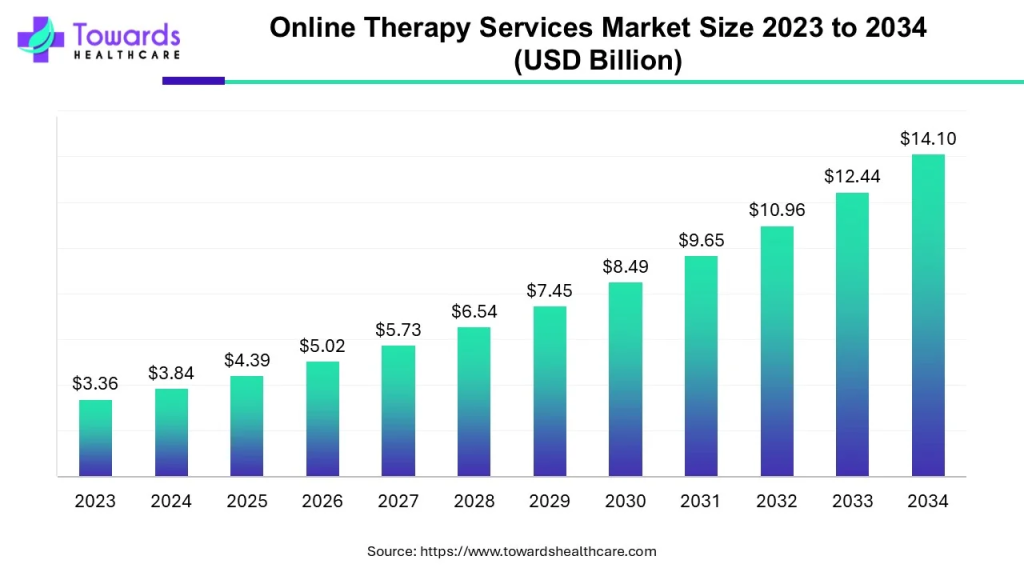
Wysa, a leading AI-powered mental health chatbot, has raised over $30.5 million across nine funding rounds, generating an estimated $11.4 million in annual revenue. Its adoption by the UK National Health Service further demonstrates its clinical credibility and practical value.
Ada Health, founded in 2011, raised $200M with a $1.2B valuation in 2024 and reported $70.M in revenue, offering AI-driven mental health assessments and expanding in the U.S., showing strong global growth potential.
Why Anyone Should Invest in a White-Label Therapy Platform?
Investing in a white-label therapy platform offers a fast, cost-effective way to enter the growing digital mental health market. It combines speed, compliance, and scalability to deliver value to providers, patients, and investors alike.
- Rapid Time-to-Market: Launch a branded therapy solution in weeks rather than months, gaining a competitive edge in the fast-growing telehealth market.
- Reduced Development Costs: Avoid expensive custom builds by leveraging pre-built infrastructure and compliance modules.
- Regulatory Compliance: Benefit from built-in HIPAA/GDPR compliance tools, reducing legal risk and operational complexity.
- Scalability: Easily add features, integrate AI tools, or expand to multiple markets without costly redevelopment.
- Brand Customization: Fully rebrand and customize the platform to maintain your unique identity and strengthen trust with users.
- Access to Advanced Features: Benefit from AI-assisted therapy capabilities like automated notes, emotional analysis, and personalized recommendations without building them from scratch.

How White-Label Solutions Cut Development Time and Costs?
White-label solutions are ready-made platforms that help healthcare providers launch their own branded products quickly, without starting from zero. This method cuts down on development time and costs, while still offering a reliable and scalable product.
1. Ready-Made Frameworks
With a pre-built core, white-label solutions remove the need to build app architecture from the ground up. Providers can launch in weeks instead of months. In today’s fast-moving healthcare market, getting to market quickly is more important than ever.
2. Lower Development Costs
White-label solutions use proven code, so there’s no need to build everything from scratch. This means smaller engineering teams, fewer resources, and less trial and error, which all add up to big savings.
3. Pre-Built Compliance Modules
Healthcare apps have to follow strict rules like HIPAA or GDPR. Many white-label platforms include built-in compliance tools, so providers don’t have to spend extra time or money building them. This lets teams focus on delivering quality care instead of worrying about regulations.
4. Tested UI/UX
White-label solutions come with ready-designed, tested user interfaces optimized for patient engagement and therapist usability. This removes weeks of UI/UX development and testing, allowing quicker deployment without sacrificing usability or patient satisfaction.
5. Scalable Architecture
White-label platforms are built to scale, enabling providers to add features or integrate new tools without costly re-engineering. This future-proofs the app, allowing businesses to adapt to growing user needs without significant redevelopment costs.
6. Reduced Maintenance
White-label platforms handle updates, bug fixes, and security patches, lowering maintenance costs and reducing the need for a full-time tech team. They enable faster deployment and scalability, letting businesses focus on growth and service.
Key Features of a White-Label Virtual Therapy App
White-label virtual therapy apps bring together essential telehealth features and advanced AI, so healthcare providers can quickly launch their own branded platforms. This helps improve care quality, user experience, and how smoothly clinics run.

1. Custom Branding & UI Personalization
This feature lets healthcare providers customize the app’s appearance, including the logo, fonts, colors, and layout, to match their brand. Personalizing the branding helps build patient trust, encourages engagement, and sets the service apart from others.
2. Secure Video & Chat Sessions
Privacy is essential for virtual therapy. Encrypted video calls and chat tools keep conversations between patients and therapists confidential. These features meet HIPAA and GDPR standards, so sessions stay secure and run smoothly.
3. AI-Powered Real-Time Transcription & Summarization
These tools use Natural Language Processing to transcribe therapy sessions as they happen. They also create structured clinical notes like SOAP formats, which saves therapists time on paperwork and keeps patient records accurate and consistent.
4. Emotional & Sentiment Analysis
AI-powered sentiment analysis looks at speech patterns, tone, pauses, and word choice to spot emotional changes or signs of stress. This gives therapists a better understanding of how patients feel, so they can make more informed treatment decisions.
5. Personalized Therapy Recommendations
With AI, the app can suggest personalized recommendations after each session. These might include self-care exercises, changes to the therapy plan, or educational resources that fit the patient’s needs, making therapy more effective and engaging.
6. Appointment Scheduling & Calendar Management
A built-in scheduling system lets patients book or reschedule sessions, and therapists can update their availability as needed. Automated reminders help reduce missed appointments and keep the clinic running smoothly.
7. Progress Tracking Dashboards
These dashboards show visual updates on therapy progress, including session history, mood trends and results. Therapists and patients can both track improvements, which helps therapists adjust treatment and keeps patients motivated.
8. Integrated Payment & Subscription Management
Secure payment systems and subscription tools make it easy to bill for sessions or therapy packages. Clear invoices, auto-renewal, and different payment options make things easier for patients and help providers maintain steady income.
9. Compliance & Data Security Modules
Compliance tools help the app meet rules like HIPAA in the U.S. and GDPR in Europe. Features such as end-to-end encryption, secure cloud storage, and access controls protect patient data and let therapists access what they need safely.
10. Analytics & Reporting Tools
Advanced analytics let providers track usage, patient progress, session trends, and how the platform is performing. These insights help clinics improve their services, boost patient engagement, and make better business decisions.

White-Label Virtual Therapy App Development Guide
Developing a white-label virtual therapy app requires a clear roadmap that blends healthcare compliance, AI capabilities, user-centric design, and robust backend infrastructure. This guide walks you through the essential steps from planning to launch.

1. Consultation
Our developers begin by thoroughly analyzing target audiences, including patients, clinics, and mental health professionals. We conduct competitor research, identify market gaps, and define the app’s scope, compliance requirements, features, and AI capabilities to ensure the product meets real-world demands.
2. UI/UX Design and Branding Strategy
We design emotionally comforting and accessible interfaces that make therapy sessions intuitive for patients while allowing therapists to manage tools efficiently. Our team customizes branding elements like logos, colors, and typography to reflect the client’s identity and build trust across platforms.
3. Core Feature Development for MVP
At the MVP stage, we focus on developing essential functionalities such as HIPAA-compliant video and chat, appointment scheduling, user onboarding, AI-assisted transcription, and patient dashboards. This allows fast market entry, early feedback collection, and validation of the app’s core value.
4. AI Integration
Our developers implement advanced AI features including NLP, sentiment analysis, and behavioral pattern recognition. Real-time transcription, emotional tone detection, and personalized therapy recommendations are integrated to enhance patient engagement while reducing therapists’ administrative workload.
5. Compliance and Security Implementation
We enforce end-to-end encryption, secure cloud storage, role-based access, and two-factor authentication to protect sensitive data. Our team ensures full compliance with HIPAA, GDPR, and local regulations while implementing audit trails to maintain trust and minimize legal risks.
6. Testing and Quality Assurance
We conduct rigorous testing covering functionality, performance, security, and usability. Compliance verification is integrated into quality assurance to guarantee the app is reliable, fast, secure, and provides an intuitive experience for both patients and therapists.
7. Deployment and Integration
Our team deploys the app across iOS, Android, and web platforms, integrating payment gateways, cloud storage, analytics, and healthcare systems like EHRs. This ensures the app is secure, scalable, and ready for real-world use while supporting seamless workflows.
8. Post-Launch Support
After launch, we continuously monitor performance, gather feedback, and release updates including AI improvements, security patches, feature enhancements, and compliance upgrades. This iterative approach keeps the app competitive, efficient, and aligned with evolving healthcare needs.
Cost to Build White-Label Virtual Therapy App
The cost to build a white-label virtual therapy app varies based on features, AI integration, compliance requirements, and platform support. Understanding the key cost factors helps businesses plan budgets effectively while ensuring a secure and high-quality therapy solution.
| Development Phase | Estimated Cost | Short Description |
| Requirements Gathering and Market Research | $7,000 – $13,000 | Define platform goals, target users, therapy frameworks, and core MVP features. Collect data for AI and feature planning. |
| UI/UX Design and Branding Strategy | $8,000 – $15,000 | Design intuitive interfaces, conversational flows, and visual identity to create engaging, accessible experiences across devices. |
| Core Feature Development for MVP | $15,000 – $25,000 | Build essential features like onboarding, chat interface, session scheduling, mood tracking, and therapy dashboards for launch. |
| AI Integration | $12,000 – $22,000 | Integrate NLP, sentiment analysis, emotion detection, and recommendation engines. Fine-tune AI for personalized therapy and adaptive interactions. |
| Compliance and Security Implementation | $7,000 – $12,000 | Implement HIPAA/GDPR-compliant encryption, secure APIs, RBAC, and audit trails to protect sensitive mental health data. |
| Testing and Quality Assurance | $6,000 – $10,000 | Conduct functional, integration, and AI-specific testing to validate performance, accuracy, and user experience. |
| Deployment and Integration | $8,000 – $14,000 | Deploy on cloud infrastructure, integrate APIs, enable real-time communication, and optimize for scalability and performance. |
| Post-Launch Support and Continuous Improvement | $7,000 – $11,000 | Monitor AI, update features, analyze user feedback, and enhance therapy recommendations and overall platform usability. |
Total Estimated Cost: $60,000 – $125,000
Note: This is an estimated cost breakdown to give a clear understanding of the investment required for building an AI-powered virtual therapy platform. Consult with IdeaUsher for tailored guidance and development support to bring your platform vision to life.

Tech Stack for White-Label Virtual Therapy App Development
Choosing the right tech stack is critical for building a secure, scalable, and feature-rich white-label virtual therapy platform. The stack must support HIPAA compliance, real-time communication, AI capabilities, and a seamless user experience.
1. Frontend Development
The frontend is what users directly interact with, and it must be responsive, intuitive, and visually appealing.
- React.js / Angular / Vue.js: Modern JavaScript frameworks that allow developers to build dynamic, component-based interfaces with fast load times and responsive design. These ensure a smooth experience for both patients and therapists.
- React Native / Flutter: Cross-platform frameworks that let developers build mobile apps with near-native performance while reusing a single codebase for both iOS and Android platforms. This speeds up development and reduces cost.
- HTML5, CSS3, JavaScript: The foundational web technologies for creating structured, styled, and interactive user interfaces. They ensure the app is accessible, visually consistent, and performant across devices.
2. Backend Development
The backend powers the app, processes requests, handles logic, and manages sensitive data securely.
- Node.js / Django / Ruby on Rails: High-performance backend frameworks for handling large-scale, real-time requests. They allow rapid development while ensuring scalability and maintainability for growing platforms.
- Express.js / Flask: Lightweight frameworks for creating APIs efficiently. They streamline communication between the frontend and backend while reducing unnecessary complexity.
- GraphQL / REST APIs: API protocols that handle data exchange between the frontend and backend. GraphQL allows precise queries for only the needed data, reducing load times, while REST is simple and widely supported.
3. Database Management
Databases store all therapy session records, user profiles, and AI-generated insights securely.
- PostgreSQL / MySQL: Relational databases perfect for structured health data storage, ensuring data integrity and powerful query capabilities.
- MongoDB: A flexible NoSQL database ideal for handling unstructured or varied data formats, such as session transcripts or AI analysis outputs.
- Firebase / Amazon RDS: Cloud-hosted database services that provide scalability, high availability, and automatic backups to ensure uninterrupted service.
4. Real-Time Communication
A core feature of virtual therapy is the ability to connect in real time via video, audio, and chat.
- WebRTC: A technology enabling peer-to-peer video, audio, and data sharing directly within browsers and apps without extra plugins. It ensures high-quality sessions with minimal latency.
- Twilio / Agora.io / Vonage: Communication APIs that provide secure, scalable real-time capabilities for video calls, voice sessions, and chat integration. They include features such as adaptive bandwidth and session recording.
5. AI & NLP Modules
AI powers personalization, emotional analysis, and efficient documentation in therapy apps.
- Google Cloud AI / AWS AI Services / Azure Cognitive Services: AI platforms that provide pre-built NLP tools, sentiment analysis, and speech-to-text conversion for faster development of intelligent features.
- spaCy / NLTK / Hugging Face Transformers: Advanced NLP libraries for custom language processing, especially useful for recognizing medical terms and extracting insights from therapy transcripts.
6. Cloud & Infrastructure
Cloud platforms power the scalability, reliability, and performance of the app.
- Amazon Web Services (AWS) / Google Cloud Platform (GCP) / Microsoft Azure: Cloud service providers offering storage, computing power, AI modules, and secure hosting to ensure the platform can grow without downtime.
- Docker / Kubernetes: Containerization and orchestration tools that streamline deployment, ensure consistent environments, and enable easy scaling of app components.
7. Security & Compliance Tools
Ensuring the protection of patient data is non-negotiable in healthcare.
- OAuth 2.0 / OpenID Connect / JWT: Protocols for secure authentication and authorization, ensuring only verified users can access sensitive data.
- SSL/TLS Encryption: Secures data in transit between users and servers, preventing eavesdropping or tampering.
- HIPAA-Compliant Cloud Storage Solutions: Ensures all patient data is stored according to strict legal regulations, protecting privacy and avoiding costly compliance violations.
Monetization Models for White-Label Virtual Therapy Platforms
White-label virtual therapy platforms offer varied monetization strategies tailored to different audiences. The choice of model depends on the target market, service scope, and growth strategy.
1. Subscription-Based Model
A subscription-based model offers consistent revenue through recurring payments. It can include individual subscriptions for patients and institutional subscriptions for healthcare providers, ensuring steady cash flow while encouraging ongoing engagement.
2. Pay-Per-Session Model
Users pay for each therapy session they attend. This flexible model appeals to occasional users and those seeking niche services. It provides transparent billing and attracts first-time users unwilling to commit to subscriptions.
3. Freemium Model
The freemium model offers basic services for free, with premium tools available at a cost. This attracts more users initially and converts engaged ones into paying customers through added-value upgrades like personalized therapy plans and priority scheduling.
4. Licensing for Providers
Healthcare organizations pay a licensing fee to access and brand the platform. This allows providers to quickly deploy a therapy solution without custom development while ensuring recurring revenue for the provider.
5. Partnership & Affiliate Model
Revenue comes from collaborations with healthcare providers, wellness brands, or insurance companies. Partnerships can expand reach, enhance credibility, and add income streams via referrals, integrations, or co-branded services.
Conclusion
Building a white label therapy app offers healthcare providers and startups a faster route to launch scalable, compliant, and branded mental health platforms. With the right partner, you can integrate advanced features like AI matching, telehealth sessions, and data analytics while maintaining your unique brand identity. It bridges the gap between accessibility and personalization in digital therapy, empowering both professionals and patients with smarter care delivery. As virtual healthcare adoption accelerates, investing in such platforms creates lasting value for users and organizations alike.
Why Choose IdeaUsher for Your White-Label Therapy App Development?
IdeaUsher helps businesses launch customizable, secure white-label therapy apps that enable therapists to provide accessible mental health care. Our solutions are designed for rapid deployment, scalability, and a seamless user experience.
Why Work with Us?
- Mental Health Tech Expertise: We develop apps that combine technology with clinical best practices for effective therapy delivery.
- Custom Branding: Tailor the app’s features, design, and workflow to align with your brand and user needs.
- Proven Success: We have delivered white-label solutions that empower providers to expand their digital mental health services efficiently.
- Data Security & Compliance: Our platforms adhere to privacy and healthcare standards, ensuring patient data protection and trust.
Explore our portfolio and discover the range of white-label therapy apps we’ve successfully delivered.
Contact us today for a consultation and bring your digital mental health platform to life.
Work with Ex-MAANG developers to build next-gen apps schedule your consultation now
FAQs
A white-label therapy app is a ready-made platform that healthcare providers or startups can customize with their own branding. It allows quick deployment of online therapy services without developing a platform from scratch.
Key features include video sessions, AI-driven mood tracking, appointment scheduling, secure messaging, therapist dashboards, and payment integration. These features enable therapists to deliver personalized, secure, and accessible mental health care to users.
The cost of developing a white-label therapy app generally ranges between $65,000 – $135,000, depending on feature customization, platform type, and integration needs. Ready-made solutions can lower initial costs and accelerate launch timelines.
Investing in a white-label therapy app helps businesses enter the digital health market faster with reduced development costs. It also provides flexibility for branding, scalability, and feature expansion based on user feedback and market demand.
